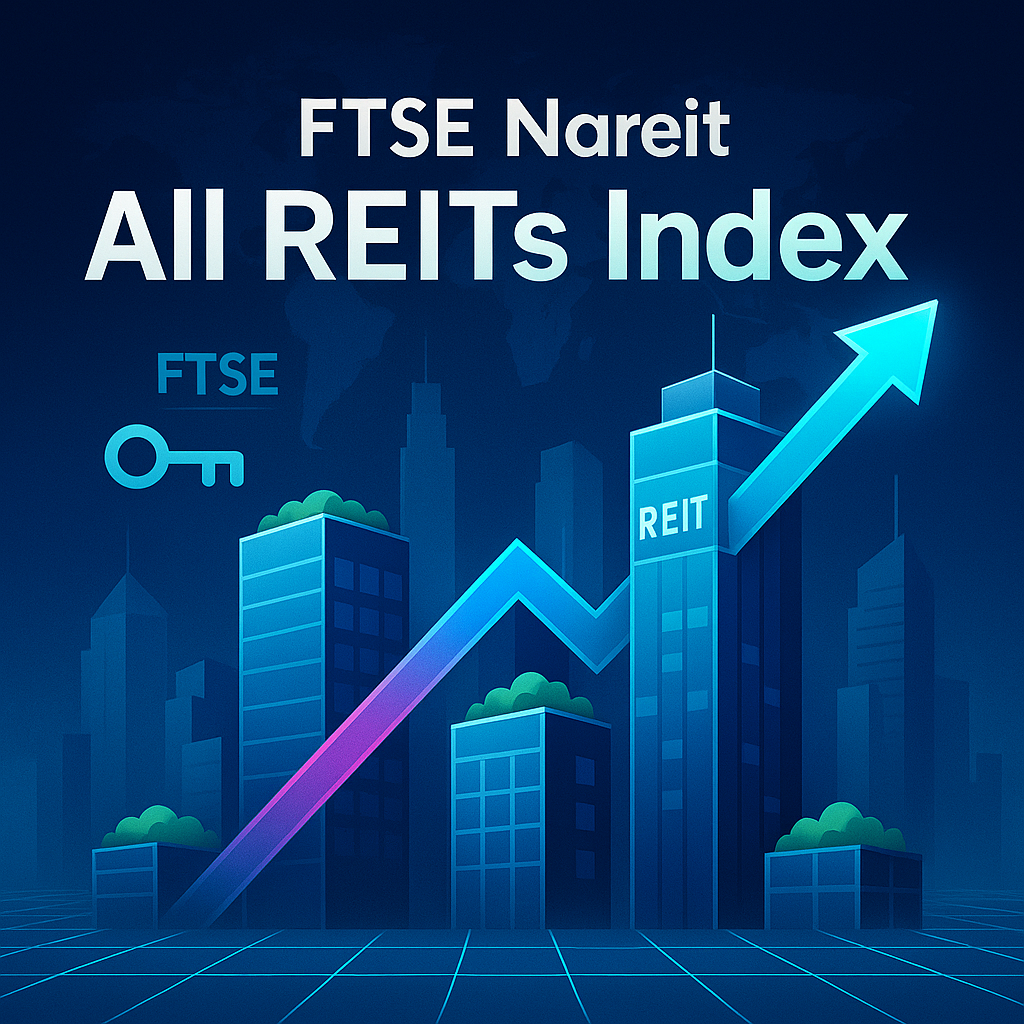A comprehensive benchmark that covers every equity and mortgage REIT listed on U.S. exchanges—thereby spanning housing, warehouses, offices, data centers, self-storage, and beyond. Consequently, it offers an all-in snapshot of America’s income-producing real-estate market.
1. What the Index Captures
Launched in 1972, the FTSE Nareit All REITs Index first tracks more than 200 real-estate investment trusts (REITs) whose combined free-float market value exceeds US $1.4 trillion (April 2025). Next, because it is free-float market-cap-weighted and rebalanced monthly, it therefore reflects both price movement as well as dividend distributions in a timely manner.

2. Composition Snapshot (April 2025)
| Sector | Weight | Yield | Transition Note |
|---|---|---|---|
| Industrial / Logistics | 19 % | 2.7 % | First and foremost, e-commerce warehouses dominate. |
| Residential (Apts & SFR) | 15 % | 3.1 % | Meanwhile, rental housing provides steady cash flow. |
| Retail (Malls & Strip) | 12 % | 4.9 % | Conversely, higher yields compensate for foot-traffic risk. |
| Data Centers | 10 % | 2.0 % | Moreover, AI workloads fuel growth. |
| Self-Storage | 6 % | 3.8 % | Likewise, move-driven demand stays resilient. |
| Healthcare | 8 % | 5.0 % | Additionally, ageing demographics support occupancy. |
| Diversified & Other | 30 % | 5.1 % | Collectively, assorted niches round out exposure. |
| Index Dividend Yield | — | 4.3 % | Thus, income remains attractive. |
Mortgage REITs contribute approximately 5 % of index weight yet almost 15 % of total dividends—thereby lifting the overall yield.
3. 2024 – 2025 Performance Pulse
| Period | Total Return | Key Driver | Transition Note |
|---|---|---|---|
| 2024 | +5.9 % | Rate stabilisation, FFO growth | After 2022’s shock, rates calmed. |
| YTD-2025 | +7.1 % | Data-center rally, resilient housing | Furthermore, tech demand accelerated. |
The index initially lagged the S&P 500 during 2022’s rate shock (-24 %); however, it outperformed global equities during 2019-2020’s late-cycle phase—thereby highlighting its defensive tilt.
4. Why Investors Use It
- Broad Sector Beta. Because it captures every U.S. REIT, it therefore provides the widest property snapshot—unlike narrow sub-indices.
- High Dividend Stream. A current 4 % + yield, paid quarterly, thus enriches income budgets.
- Inflation Alignment. Rent escalators plus replacement-cost barriers furthermore preserve real returns.
- ETF Underpinning. Funds such as VNQ and SCHH track or benchmark to this index; consequently, access is easy and liquid.
5. Strengths & Limitations
| Strengths | Limitations |
|---|---|
| To begin with, monthly rebalances keep sector weights current. | However, market-cap weighting overexposes mega-cap industrial/data-center names. |
| Moreover, a long history enables cycle analysis. | Meanwhile, mortgage-REIT inclusion raises leverage and volatility. |
| Finally, float-adjusted shares filter insiders. | Conversely, pure U.S. listing focus omits global property exposure. |
6. 2025 Themes to Watch
- AI-Driven Demand. Data-center REIT FFO is projected to grow 13 %; therefore, the sector may extend leadership.
- Hybrid-Work Drag. Office vacancy sits near 19 %; accordingly, index weight remains below 3 %.
- Green Premiums. ESG-certified buildings trade at 20 bp lower cap rates, thus lifting NAVs.
- Interest-Rate Path. Two Fed cuts priced for Q4 2025; hence, duration effects could lift high-yielding retail and healthcare REITs.
Key Takeaways
The FTSE Nareit All REITs Index is the definitive barometer for U.S. listed property, blending equity-style growth with bond-like income. As of April 2025, it delivers a 4.3 % dividend yield across 200 + constituents, with sector leadership from industrial and data-center names. Ultimately, investors rely on it for diversified real-estate exposure, precise benchmarking, and dependable income in multi-asset portfolios.
o3